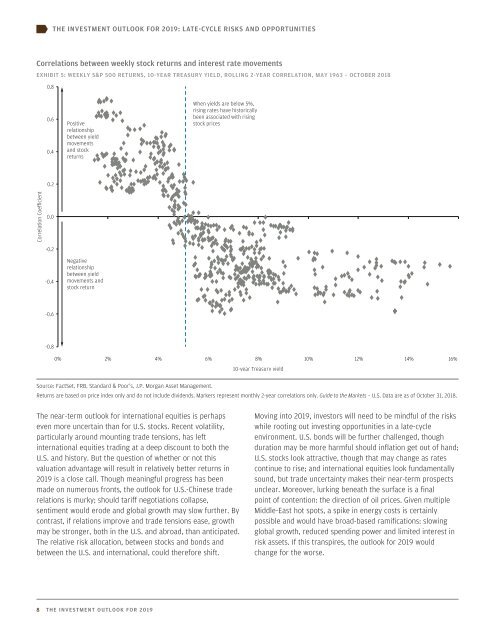Create successful ePaper yourself
Turn your PDF publications into a flip-book with our unique Google optimized e-Paper software.
THE INVESTMENT OUTLOOK FOR 2019: LATE-CYCLE RISKS AND OPPORTUNITIES<br />
Correlations between weekly stock returns and interest rate movements<br />
EXHIBIT 5: WEEKLY S&P 500 RETURNS, 10-YEAR TREASURY YIELD, ROLLING 2-YEAR CORRELATION, MAY 1963 – OCTOBER 2018<br />
0.8<br />
0.6<br />
0.4<br />
Positive<br />
relationship<br />
between yield<br />
movements<br />
and stock<br />
returns<br />
When yields are below 5%,<br />
rising rates have historically<br />
been associated with rising<br />
stock prices<br />
0.2<br />
Correlation Coefficient<br />
0.0<br />
-0.2<br />
-0.4<br />
Negative<br />
relationship<br />
between yield<br />
movements and<br />
stock return<br />
-0.6<br />
-0.8<br />
0% 2% 4% 6% 8%<br />
10%<br />
12% 14%<br />
10-year Treasury yield<br />
16%<br />
Source: FactSet, FRB, Standard & Poor’s, J.P. Morgan Asset Management.<br />
Returns are based on price index only and do not include dividends. Markers represent monthly 2-year correlations only. Guide to the Markets – U.S. Data are as of October 31, 2018.<br />
The near-term outlook for international equities is perhaps<br />
even more uncertain than for U.S. stocks. Recent volatility,<br />
particularly around mounting trade tensions, has left<br />
international equities trading at a deep discount to both the<br />
U.S. and history. But the question of whether or not this<br />
valuation advantage will result in relatively better returns in<br />
2019 is a close call. Though meaningful progress has been<br />
made on numerous fronts, the outlook for U.S.-Chinese trade<br />
relations is murky; should tariff negotiations collapse,<br />
sentiment would erode and global growth may slow further. By<br />
contrast, if relations improve and trade tensions ease, growth<br />
may be stronger, both in the U.S. and abroad, than anticipated.<br />
The relative risk allocation, between stocks and bonds and<br />
between the U.S. and international, could therefore shift.<br />
Moving into 2019, investors will need to be mindful of the risks<br />
while rooting out investing opportunities in a late-cycle<br />
environment. U.S. bonds will be further challenged, though<br />
duration may be more harmful should inflation get out of hand;<br />
U.S. stocks look attractive, though that may change as rates<br />
continue to rise; and international equities look fundamentally<br />
sound, but trade uncertainty makes their near-term prospects<br />
unclear. Moreover, lurking beneath the surface is a final<br />
point of contention: the direction of oil prices. Given multiple<br />
Middle-East hot spots, a spike in energy costs is certainly<br />
possible and would have broad-based ramifications: slowing<br />
global growth, reduced spending power and limited interest in<br />
risk assets. If this transpires, the outlook for 2019 would<br />
change for the worse.<br />
8 THE INVESTMENT OUTLOOK FOR 2019
















